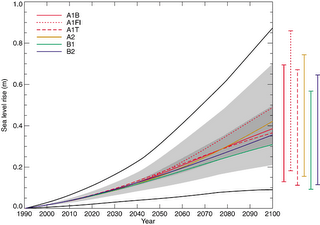Parsing greenhouse gas driven sea level rise.....
Is not trivial. We have seen the IPCC TAR predictions for sea level rise until 2100
 where the dark band is the average of all of the GCM predictions over the 35 emission scenerios. This best estimate of 30 to 40 cm by 2100 is not very scary, although it is concerning. More concerning if you live in Florida than Colorado, but still it looks like it can be handled.
where the dark band is the average of all of the GCM predictions over the 35 emission scenerios. This best estimate of 30 to 40 cm by 2100 is not very scary, although it is concerning. More concerning if you live in Florida than Colorado, but still it looks like it can be handled.
But wait, there is still more. If you look carefully (or read the text) you find that the rate of sea level rise increases in the second half of the 21st century by a factor of ~1.6 over that in the first. So, in the spirit of the second law of thermodynamics, it is going to get worse, before it gets better.
But there is STILL more, there is good evidence that there is a 50 - 100 year time lag for the global temperature due to the thermal inertia of the oceans, so, we are already committed to sea level rise, even if we stop emitting excess excess greenhouse gases today.
And since we are not going to stop emitting excess CO2 tomorrow, there is STILL MORE, if you look further out in time you get this prediction:
 The top figure is the prediction for increasing CO2 by 1% a year for 70 years and then holding it constant, the bottom is for increasing CO2 by 1% a year for 140 years and then holding it constant. If the energy content of the atmosphere and ocean increases, it will take a long time to melt a lot of ice, and warm up the ocean, but melt and warm it will. That, is already a LOT of sea level rise. So it may not get better, but at least in a few hundred years it may not get worse.
The top figure is the prediction for increasing CO2 by 1% a year for 70 years and then holding it constant, the bottom is for increasing CO2 by 1% a year for 140 years and then holding it constant. If the energy content of the atmosphere and ocean increases, it will take a long time to melt a lot of ice, and warm up the ocean, but melt and warm it will. That, is already a LOT of sea level rise. So it may not get better, but at least in a few hundred years it may not get worse.
BUT there MAY BE STILL MORE, we don't know a lot about the mechanics associated with ice sheets breaking apart. We assume that it will take millenia, but Hansen points out that it may only take centuries. That is a short enough time that if you hurry up and buy your Hummer now you may be able to screw your great grand kids. In Hansen's words:
A 20-meter sea level rise is not required to wreak havoc with civilization today. Three-quarters of a meter each from Greenland and Antarctica would do the job quite well.Things may get a lot worse before they get better.





3 comments:
As you probably know, Richard Alley (aka Prof. Frink) is even now busting his butt to finish and get results from the first real dynamical ice model. As I understand it, this should allow for an estimate of collapse over time that will be much better than the educated guesses we have now. It's already been a very interesting year for climate science, and Alley's results could make it even more so.
Hi Eli, I see a graph with multiple possible futures. Because I want disasters not to happen, that will not prevent them happening. Whether Tsunamis & earthquakes in Indonesia. Whether Hurricane Katrina in the gulf of Mexico or Hurricanes on the China coast. But it is evident you & I are two of many trying to provoke some thought. Still we just keep riding on the waves, hopefully on the crest of the wave.
Whatever the day outside may be like, whether sunny bright, whether frosty or chilly cold night, we can control our actions and emotions or reactions. We can (may)get in out of the rain, we can like the flowers turn to the sun, these choices we have, the ducks in the pond too. The flowers do it, because it is what they do. Laters ... Q
I vaguely remember reading somewhere a translation of small sea level rise to increased wave height, storm surge, etc. but have since lost the reference.
My memory is that reasonably small rises (10cm?) will magnify the effects of these (unrelated in cause) events by a considerable margin.
Post a Comment